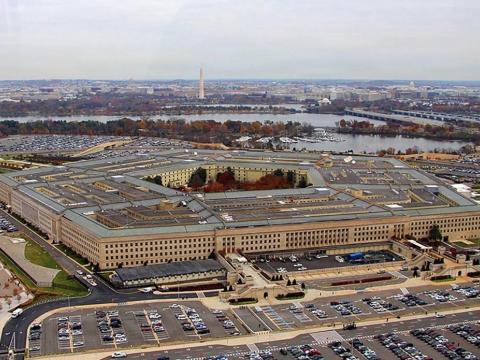Air Force to Quash Reemergence of Great Powers With Technology, Training
AFCEA TechNet Air 2016
The SIGNAL Magazine Online Show Daily, Day 3
Quote of the Day:
“We want to think deeply and thoughtfully about what is the right mix between combining what humans do best and what machines do best, not just in the combat arena … but in the process we use for command and control.”—Lt. Gen. James Holmes, USAF, deputy chief of staff for strategic plans and requirements for the Air Force
The changing world has produced a reemergence of great powers.
And the U.S. Air Force seeks to stop it.
“For 25 years, we could pretty much assume that we were going to be totally superior to anybody that we might engage against—that it wasn’t a question of whether we were going to win or not—it was how long it was going to take us to achieve our objectives,” said Lt. Gen. James Holmes, USAF, deputy chief of staff for strategic plans and requirements for the Air Force.
Russia’s recent military actions coupled with China’s military build-up have demonstrated that peer competitors to the United States have developed technologies and new ways to operate that fall just below the threshold of a full-on U.S. military response, Gen. Holmes shared Thursday during the final keynote address of AFCEA International’s inaugural TechNet Air 2016 symposium, a three-day conference drawing a number of experts to San Antonio.
As the Defense Department as a whole gears up to confront emerging threats posed by traditional and radicalized foes, the Air Force provides critical input to the department’s third offset strategy, a modernization strategy used to direct funding for research and development for technology-enabled concepts to prevail over potential opponents.
The first offset strategy was nuclear deterrence, followed by the strategy that set up the United States to be a leader in stealth and precision airpower, and in the discipline of intelligence, surveillance and reconnaissance, or ISR.
The United States used to enjoy at least a 25-year head start over its adversaries, he said. "Our technological advantage … has narrowed and it’s narrowing faster every year.”
In an effort to widen that gap, the third offset provides a general framework for innovation for technology, concepts and organization. Considering the speed at which technology develops today, however, a third offset must be followed by a fourth and fifth, in fairly rapid succession, he suggested.
Competition in the fields of technology is stiff, evident in the development of the F-35 Lightning II Joint Strike Fighter, a fifth-generation stealth aircraft already rivaled by other nations, such as the Chinese aircraft that nearly identically mirrors the F-35.
“Some of that is engineers being pushed to the same place, and some of it may or may not be stealing intellectual property to get to that,” Gen. Holmes told the audience. “Either way, it takes you to the same place.”
That is, jockeying for air superiority.
Historically, the Air Force “bought planes by the pound,” while today the cost for cutting-edge platforms is measured by the number of lines of software code, another example of technology’s impact, he offered.
Operators must also figure out how to better leverage the power of machines for the future, such as relying on machines to go through and analyze big data. Additionally, unmanned aerial vehicles could be sent out for reconnaissance missions ahead of manned aircraft to assess a target.
“We want to think deeply and thoughtfully about what is the right mix between combining what humans do best and what machines do best, not just in the combat arena … but in the process we use for command and control,” Gen. Holmes said. Man and machine need to work together, not be pitted against one another.
Part of a cultural shift places leadership focus—and dollars—on capabilities, and not on the specific platforms that have defined planning guidances in the past.
Fiscal constraints of the recent past compelled the military to rethink spending and launched the Air Force’s planning guidance leaders dubbed “breaking the cost curve,” Gen. Holmes said, echoing remarks made by Air Force Secretary Deborah Lee James spoke when she kicked off the symposium two days earlier.
While Gen. Holmes painted a broad-stroked picture of Air Force future endeavors, an earlier keynote speaker focused on the service’s plans to out-think and out-innovate cyber adversaries.
The Air Force has 67,000 members who have expertise in cyber operations, everything from computer system programs to network administrators to cyber warfare operators, said Maj. Gen. Scott A. Vander Hamm, USAF, assistant deputy chief of staff for operations.
The Air Force places much focus on its educational foundations in order to build cyber warfighters to better develop the next generation of operators, Gen. Vander Hamm said.
It is pioneering a study with the University of Maryland Center for Advanced Study of Language to establish an initial Air Force cyber aptitude battery. “This will enable the assessment of a recruit’s cognitive skills for cyber warfare and it will assist us in the placement of the right airman into the cyber work force,” he shared.
Recruits must be given the right training, and training “tailored to meet the needs of a generation that’s already very comfortable in this IT world.”
The Air Force too is establishing a cyber innovation center to provide a centralized environment where airmen can work hand-in-hand with industry, academia and government partners. A location has yet to be determined. It has also created a new cyber weapons instructor course at Nellis Air Force Base, Nevada.
Additionally, the Air Force is “reinvigorating” the Education with Industry program, offering the first of at least two internships with the software company VMWare.
Lastly, Air University seeks to establish a cyber college to provide advanced education to the warfighters, cyber operators and commanders, Gen. Vander Hamm shared.
“For mission success in the congested and contested environment, the Air Force requires a centralize strategic direction in developing and sustaining operations in, from and through cyberspace.”







Comments